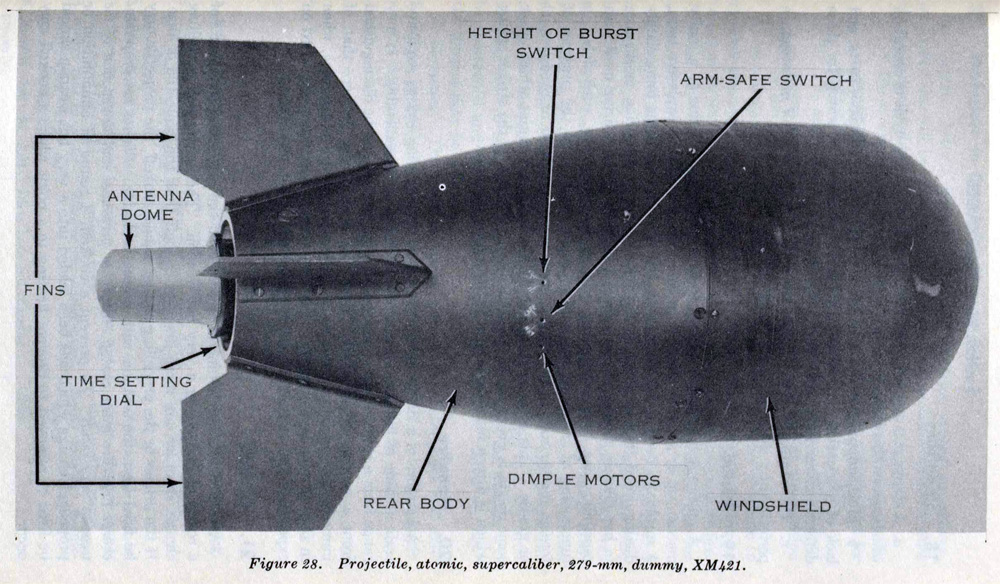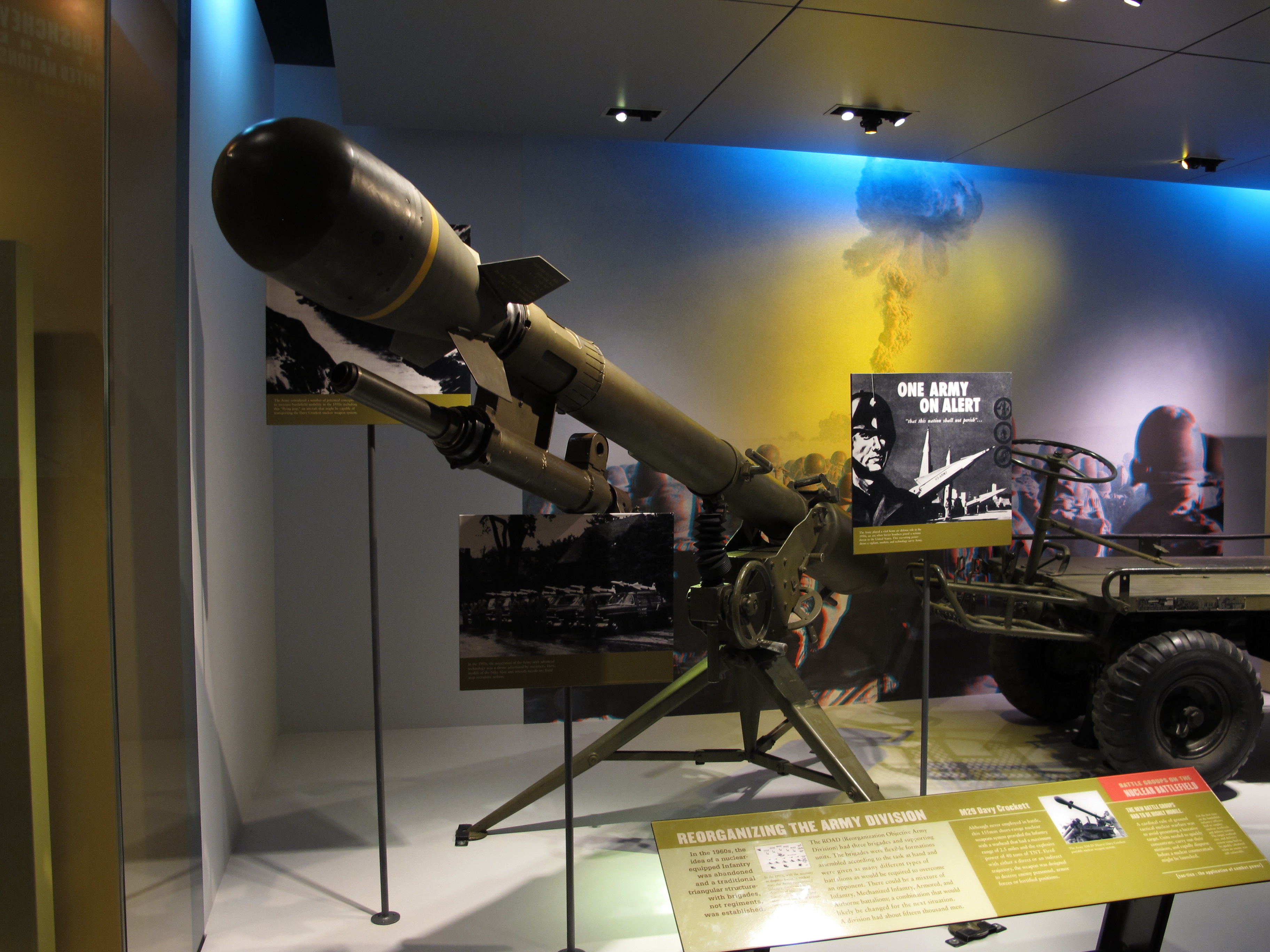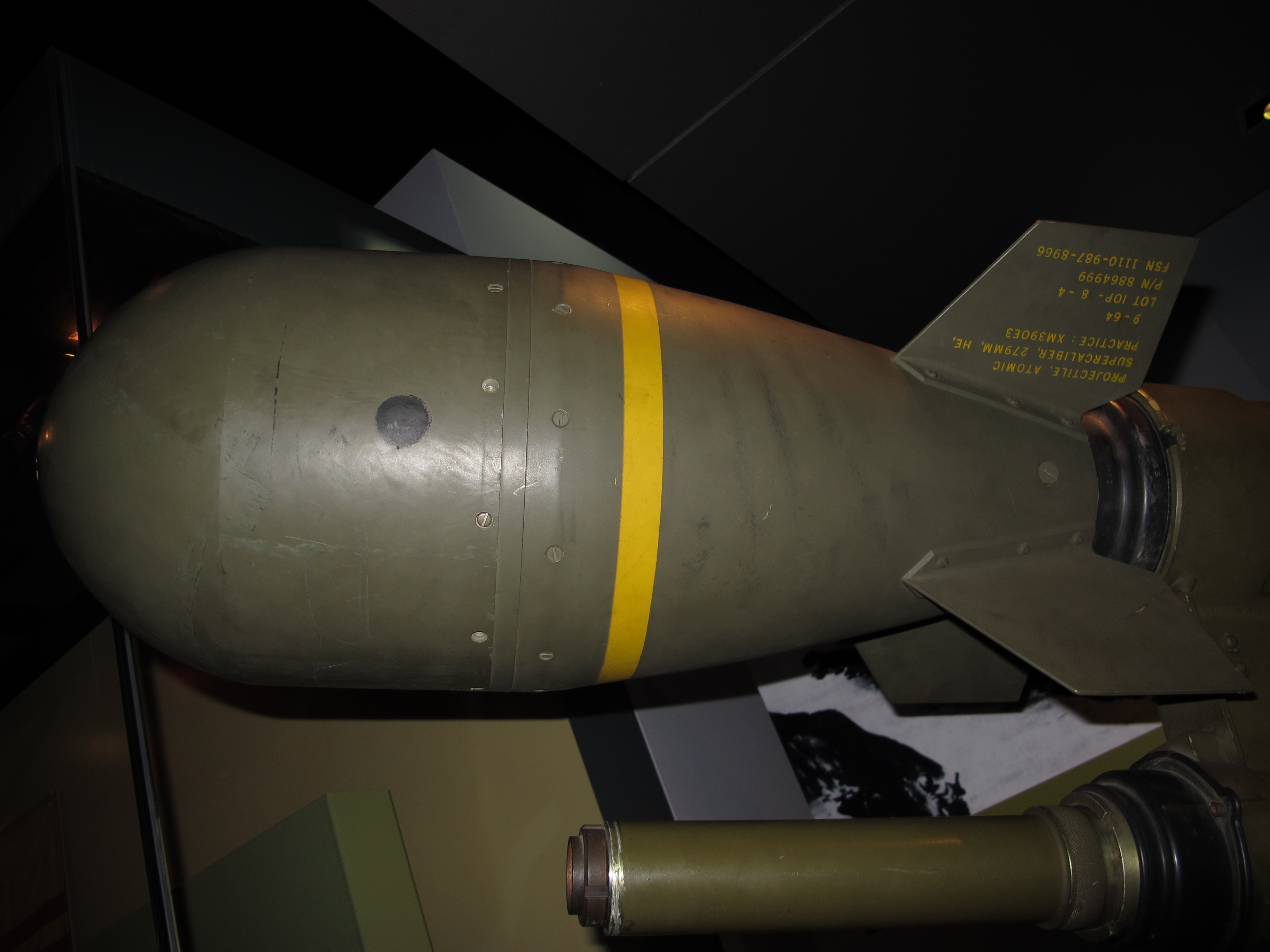Winston
Lorenzo von Matterhorn
- Joined
- Jan 31, 2009
- Messages
- 9,560
- Reaction score
- 1,748
Anyone flown a scale model of this?
Davy Crockett: King of the Atomic Frontier
https://www.damninteresting.com/davy-crockett-king-of-the-atomic-frontier/
On 17 July 1962, a caravan of scientists, military men, and dignitaries crossed the remote desert of southern Nevada to witness an historic event. Among the crowd were VIPs such as Attorney General Robert F. Kennedy and presidential adviser General Maxwell D. Taylor who had come to observe the “Little Feller I” test shot, the final phase of Operation Sunbeam. The main attraction was a secret device which was bolted to the roof of an armored personnel carrier, a contraption called the The Davy Crockett Weapon System.
The Davy Crockett shell weighed about seventy-six pounds, and it vaguely resembled a watermelon with fins. At thirty-one inches long and eleven inches in diameter, the projectile was too large to fit inside the gun, so it perched on the top while an attached rod was inserted into the barrel. The shell could be fired from a four-inch-wide recoilless rifle which could lob the bomb a little over a mile, or a larger six-inch-wide version which could heave it up to two and a half miles. The launchers were mounted to jeeps and personnel carriers, and each was operated by a three-man atomic squad. The Davy Crockett was also designed to detach from its vehicle, allowing the teams to relocate on foot and dispatch their miniature mutually-assured-destruction from a handy tripod mount.
The Atomic Battle Group was charged with the protection of Europe between 1961 and 1971, and during those ten years 2,100 of the Davy Crockett Weapons Systems were deployed. In the event of a Soviet invasion, these elite squads were trained to deploy themselves in the path of the advancing formations. Once in position, a flurry of mathematics would provide the trajectory and flight time to the targets, and these data would be used to configure the launchers for maximum carnage. A test shot with the integrated 37mm spotting gun would verify the operators’ angle and timing calculations. The three men would then unpack a shell from its carrying case, set the timer knob to detonate the warhead roughly twenty feet above the target, and dial in their preferred yield of ten or twenty tons.
Upon receiving the order to fire, Davy Crockett would leap from its perch with a bang and a cloud of smoke, racing through sky in a long arc to intercept the advancing enemy. The rudimentary atomic bomb did not include an abort feature, so Davy Crockett was committed to destruction once it was en route. Even with the help of the spotter gun and rifled barrel, both of the Davy Crockett launcher designs were somewhat sloppy in their accuracy, so the detonation was likely to be several hundred feet from the target. Moreover, the shells’ relatively small yield didn’t produce a great deal of blast damage even at the highest setting. But the weapon’s tendency to spew radiation over the battlefield made up for its shortcomings as an explosive.
Any person within a quarter-mile radius of the Davy Crockett explosion would face almost certain death. Those within the first 500 feet would be exposed to enough radiation to kill within minutes or hours, even with the protection of tank armor. People at about 1,000 feet from the blast would experience temporary fatigue and nausea which would then pass, but this misleading “walking ghost” condition leads to a painful death after a few days of apparent well-being. Those beyond a quarter-mile would have better chances of survival, though many would require extensive medical care, and perhaps never fully recover from their injuries. Those lucky enough to be more than one-third of a mile from ground zero would be spared most of the harmful effects, but the mutations in their DNA would give them an increased risk of cancer later in life.
The Davy Crockett’s timer allowed a minimum shot distance of about 1,000 feet, but such inept use of the weapon would certainly result in the deaths of the firing team. In most cases, the approaching Soviets would be at least one mile away, leaving the Atomic Battle Group personnel outside of the hazard zone. Even if the launcher’s lack of accuracy resulted in relatively few enemy casualties, the radioactivity from the hail of fission bombs would render a large swath of earth uninhabitable for about 48 hours, allowing time for American and NATO forces to mobilize.
Variations of the W54 warhead found a few other niches during the Cold War, including the Special Atomic Demolition Munition (SADM) which could be simply dropped off at a target and set to explode with a timer. A more powerful 250 ton variant was also used on the AIM-26 Falcon, a guided air-to-air missile. Fortunately these ultra-portable casualty dispensers were never used outside of the Nevada desert.
In addition to being the smallest nuclear device ever developed by the United States, the Davy Crockett also has the distinction of being the last atomic device tested by the US in the open atmosphere. The 1962 test shot at the Nevada Proving Grounds confirmed the effectiveness of the design, and the device’s tiny form factor made it a real crowd-pleaser— or a crowd killer, depending on one’s point of view. With the destructive power of twenty tons of TNT squeezed into a watermelon-sized package, it’s hard to outperform the Davy Crockett in terms of convenient annihilation per cubic inch (CACI). Though its use could have triggered a chain reaction that would have ultimately led to the destruction of humanity, it’s hard not to have a strange kind of fondness for the little feller.
King of the Wild Frontier (excellent Davy Crockett article)
https://blog.nuclearsecrecy.com/2012/07/20/king-of-the-wild-frontier/



Davy Crockett: King of the Atomic Frontier
https://www.damninteresting.com/davy-crockett-king-of-the-atomic-frontier/
On 17 July 1962, a caravan of scientists, military men, and dignitaries crossed the remote desert of southern Nevada to witness an historic event. Among the crowd were VIPs such as Attorney General Robert F. Kennedy and presidential adviser General Maxwell D. Taylor who had come to observe the “Little Feller I” test shot, the final phase of Operation Sunbeam. The main attraction was a secret device which was bolted to the roof of an armored personnel carrier, a contraption called the The Davy Crockett Weapon System.
The Davy Crockett shell weighed about seventy-six pounds, and it vaguely resembled a watermelon with fins. At thirty-one inches long and eleven inches in diameter, the projectile was too large to fit inside the gun, so it perched on the top while an attached rod was inserted into the barrel. The shell could be fired from a four-inch-wide recoilless rifle which could lob the bomb a little over a mile, or a larger six-inch-wide version which could heave it up to two and a half miles. The launchers were mounted to jeeps and personnel carriers, and each was operated by a three-man atomic squad. The Davy Crockett was also designed to detach from its vehicle, allowing the teams to relocate on foot and dispatch their miniature mutually-assured-destruction from a handy tripod mount.
The Atomic Battle Group was charged with the protection of Europe between 1961 and 1971, and during those ten years 2,100 of the Davy Crockett Weapons Systems were deployed. In the event of a Soviet invasion, these elite squads were trained to deploy themselves in the path of the advancing formations. Once in position, a flurry of mathematics would provide the trajectory and flight time to the targets, and these data would be used to configure the launchers for maximum carnage. A test shot with the integrated 37mm spotting gun would verify the operators’ angle and timing calculations. The three men would then unpack a shell from its carrying case, set the timer knob to detonate the warhead roughly twenty feet above the target, and dial in their preferred yield of ten or twenty tons.
Upon receiving the order to fire, Davy Crockett would leap from its perch with a bang and a cloud of smoke, racing through sky in a long arc to intercept the advancing enemy. The rudimentary atomic bomb did not include an abort feature, so Davy Crockett was committed to destruction once it was en route. Even with the help of the spotter gun and rifled barrel, both of the Davy Crockett launcher designs were somewhat sloppy in their accuracy, so the detonation was likely to be several hundred feet from the target. Moreover, the shells’ relatively small yield didn’t produce a great deal of blast damage even at the highest setting. But the weapon’s tendency to spew radiation over the battlefield made up for its shortcomings as an explosive.
Any person within a quarter-mile radius of the Davy Crockett explosion would face almost certain death. Those within the first 500 feet would be exposed to enough radiation to kill within minutes or hours, even with the protection of tank armor. People at about 1,000 feet from the blast would experience temporary fatigue and nausea which would then pass, but this misleading “walking ghost” condition leads to a painful death after a few days of apparent well-being. Those beyond a quarter-mile would have better chances of survival, though many would require extensive medical care, and perhaps never fully recover from their injuries. Those lucky enough to be more than one-third of a mile from ground zero would be spared most of the harmful effects, but the mutations in their DNA would give them an increased risk of cancer later in life.
The Davy Crockett’s timer allowed a minimum shot distance of about 1,000 feet, but such inept use of the weapon would certainly result in the deaths of the firing team. In most cases, the approaching Soviets would be at least one mile away, leaving the Atomic Battle Group personnel outside of the hazard zone. Even if the launcher’s lack of accuracy resulted in relatively few enemy casualties, the radioactivity from the hail of fission bombs would render a large swath of earth uninhabitable for about 48 hours, allowing time for American and NATO forces to mobilize.
Variations of the W54 warhead found a few other niches during the Cold War, including the Special Atomic Demolition Munition (SADM) which could be simply dropped off at a target and set to explode with a timer. A more powerful 250 ton variant was also used on the AIM-26 Falcon, a guided air-to-air missile. Fortunately these ultra-portable casualty dispensers were never used outside of the Nevada desert.
In addition to being the smallest nuclear device ever developed by the United States, the Davy Crockett also has the distinction of being the last atomic device tested by the US in the open atmosphere. The 1962 test shot at the Nevada Proving Grounds confirmed the effectiveness of the design, and the device’s tiny form factor made it a real crowd-pleaser— or a crowd killer, depending on one’s point of view. With the destructive power of twenty tons of TNT squeezed into a watermelon-sized package, it’s hard to outperform the Davy Crockett in terms of convenient annihilation per cubic inch (CACI). Though its use could have triggered a chain reaction that would have ultimately led to the destruction of humanity, it’s hard not to have a strange kind of fondness for the little feller.
King of the Wild Frontier (excellent Davy Crockett article)
https://blog.nuclearsecrecy.com/2012/07/20/king-of-the-wild-frontier/







